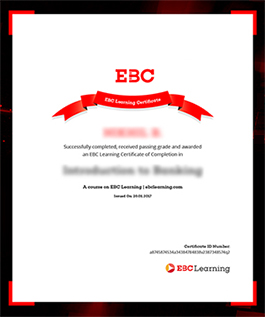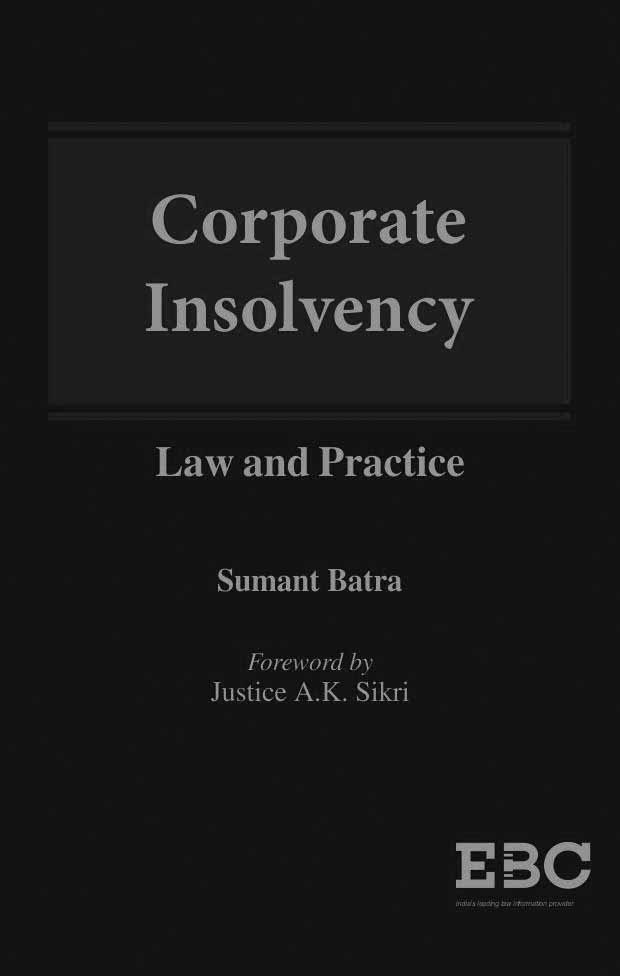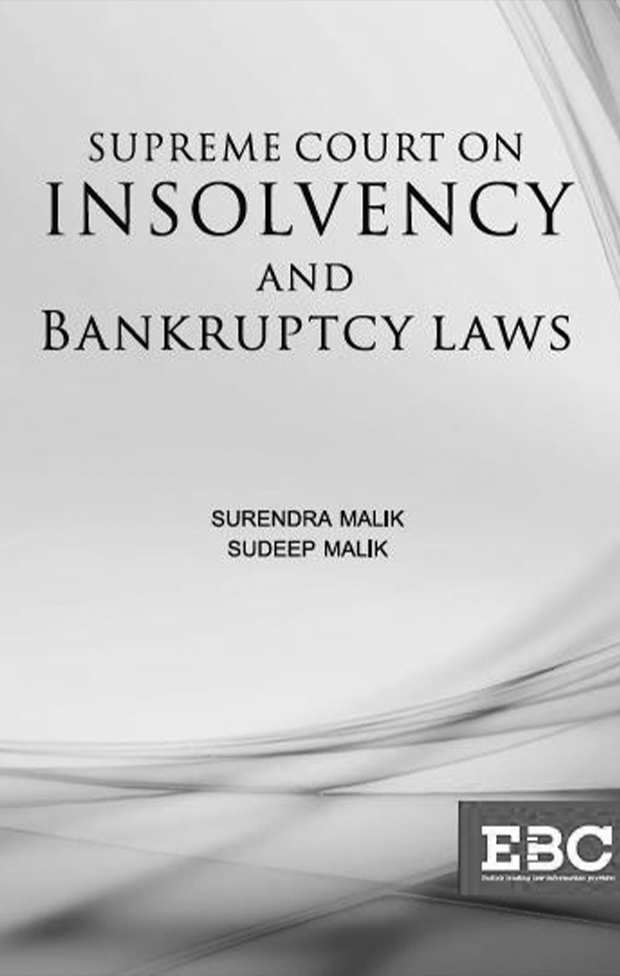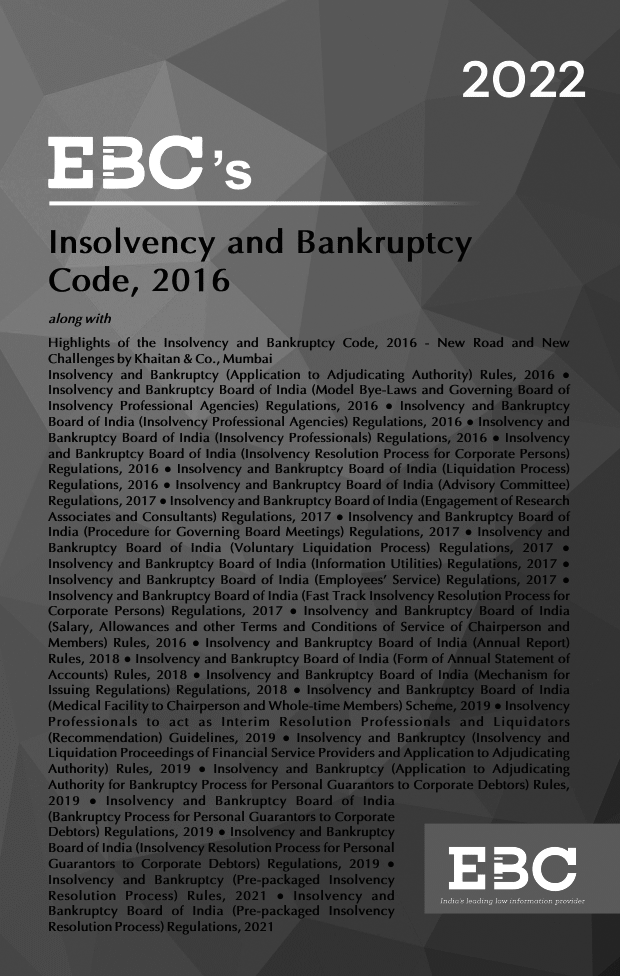


IBC consolidates all the laws related to insolvency in India by creating a single law. It helps to improve the confidence of the banks, foreign investors, and associated companies in crisis-mitigation mechanisms.
The two-week intensive course on IBC Practice contains the following:
- IBC essentials
- Initiating insolvency process
- Filing by operational and financial creditors
- Insolvency resolution process
- Fast-tracks and pre-packs
- Corporate asset valuation
- Liquidation
- Insolvency litigations and related drafting
The course will take you through the various stages in the resolution process commencing from the invitation of expression of interest for the Resolution Plan to the filing of the Resolution Plan with the NCLT for its approval.
Know who can and who cannot be a Resolution Applicant. Know the valuation requirements and application of various valuation methodologies. Understand fast-track CIRP and the provisions related to cross-border conditions. Learn how to file an insolvency petition as a financial creditor, operational creditor or corporate applicant.
As part of the course, you will get to access:
- High-quality video materials
- 10 hours of dedicated live learning
- Recordings of the live sessions
- Curated materials and assignments divided into 22 Chapters
- Books on IBC at EBC Reader
- Full text of cases from SCC Online
- EBC Learning Certificate
- The classes will be conducted primarily in the evening and two full-day Saturday workshops.

The unluckiest insolvent in the world is the man whose expenditure of speech is too great for his income of ideas.
Christopher Morley- I. Student Lounge
- Visit student lounge
- 1. Introduction: Insolvency and Bankruptcy Code Essentials
- ▸ 1.1 Introduction
- 𝍭 I. Full text of leading cases
- 2. Understanding the objectives and key terms under the IBC
- § I. Relevant sections
- ▸ 2.1 Insolvency and bankruptcy
- ▸ 2.2 Operational debt
- ▸ 2.3 Financial debt
- ▸ 2.4 Creditor
- ▸ 2.5 Financial creditor and operational creditor
- 𝍭 II. Examination pointers
- 𝍭 III. Full text of leading cases
- 3. The IBC ecosystem
- § I. Relevant sections
- ▸ 3.1 Insolvency regulator and adjudicating authorities
- ▸ 3.2 Insolvency professional
- ▸ 3.3 Insolvency professional agency
- ▸ 3.4 Information utility, financial information
- 𝍭 II. Examination pointers
- ◆ Live Class 1: IBC An Introduction
- ⚑ LIVE CLASS 1
- ⦿ LIVE CLASS 1 - Recording
- 4. Initiating the corporate insolvency process
- § I. Relevant sections
- ▸ 4.1 Triggers for Corporate Insolvency Resolution Process (CIRP)
- ▸ 4.2 Who can initiate the CIRP?
- ▸ 4.3 Who cannot file a CIRP application?
- ▸ 4.4 Where to file a CIRP initiation petition?
- ▸ 4.5 Procedure before the NCLT
- ▸ 4.6 Moratorium
- ▸ 4.7 Timelines for resolution process
- 𝍭 II. Examination pointers
- 𝍭 III. Full text of leading cases
- 5. Introduction: Filing a Petition under IBC – Initiating CIRP
- ▸ 5.1 Welcome
- 𝍭 I. Examination pointers
- 6. General meetings
- § I. Relevant sections
- ▸ 6.1 Locus and jurisdiction
- ▸ 6.2 Who cannot invoke?
- 7. Filing by financial creditors
- § I. Relevant sections
- ▸ 7.1 Introduction
- ▸ 7.2 Initiating the Insolvency Resolution Process on default in repayment of financial debt
- ▸ 7.3 Person who can file an application under Section 7
- ▸ 7.4 Specific category of financial creditors
- ▸ 7.5 Gathering information
- ▸ 7.6 Setting the wheels in motion
- ▸ 7.7 Filing the application: Filling the form
- ▸ 7.8 Crash landing or safe landing
- ▸ 7.9 Procedural aspect
- ▸ 7.10 Accepting or rejecting application
- ▸ 7.11 Withdrawal
- ▸ 7.12 Admitting application and appointing IRP
- ▸ 7.13 Moratorium
- ▸ 7.14 Public announcement
- 𝍭 II. Examination pointers
- 𝍭 III. Full text of leading cases
- 8. Filing by operational creditors
- § I. Relevant sections
- ▸ 8.1 Introduction
- ▸ 8.2 Demand notice with invoice
- ▸ 8.3 Demand notice Form 3
- ▸ 8.4 Disputing the operational debt
- ▸ 8.5 Initiating CIRP
- ▸ 8.6 Procedure for filing
- ▸ 8.7 Notice to corporate debtor
- ▸ 8.8 Accepting application
- ▸ 8.9 Rejecting application
- 𝍭 II. Examination pointers
- 𝍭 III. Full text of leading cases
- 9. Insolvency by corporate applicant
- § I. Relevant sections
- ▸ 9.1 Introduction
- ▸ 9.2 Eligibility as a corporate applicant
- ▸ 9.3 Application by corporate applicant
- ▸ 9.4 Filing as corporate applicant
- 𝍭 II. Examination pointers
- 10. Conclusion
- ▸ 10.1 Road ahead
- Exercise Set I
- Exercise Set II
- Exercise Set III
- Exercise Set IV
- ◆ Live Class 2: Initiating CIRP
- ⚑ LIVE CLASS 2
- ⦿ LIVE CLASS 2 - Recording
- 11. Resolution process
- § I. Relevant sections
- ▸ 11.1 Committee of creditors
- ▸ 11.2 Voting share
- ▸ 11.3 Resolution applicant
- ▸ 11.4 Submission and approval of resolution plan
- 𝍭 II. Examination pointers
- 𝍭 III. Full text of leading cases
- ◆ Live Class 3: Introduction to Insolvency procedure and procedure to initiate CIRP by Financial Creditors
- ⚑ LIVE CLASS 3
- ⦿ LIVE CLASS 3 - Recording
- ◆ Live Class 4: Procedure to initiate CIRP by Operational Creditors
- ⚑ LIVE CLASS 4
- ⦿ LIVE CLASS 4 - Recording
- ◆ Live Class 5 & 6: Resolution Applicant and Resolution Plan - I & II
- ⚑ LIVE CLASS 5
- ⦿ LIVE CLASS 5 - Recording
- ⚑ LIVE CLASS 6
- ⦿ LIVE CLASS 6 - Recording
- 12. Pre-packs
- § I. Relevant sections
- ▸ 12.1 Introducing pre-packs
- ▸ 12.2 Eligibility for PPIRP
- ▸ 12.3 Pre-initiation phase
- ▸ 12.4 Application for initiation of PPIRP
- ▸ 12.5 Post-initiation phase
- ▸ 12.6 Approval of resolution plan
- ▸ 12.7 Closure of PPIRP
- 𝍭 II. Examination pointers
- Exercise Set I
- Exercise Set II
- ◆ Live Class 7: Fast Track CIRP, Prepacks & Cross border, Penalties under IBC
- ⚑ LIVE CLASS 7
- ⦿ LIVE CLASS 7 - Recording
- 13. Introduction: Corporate Assets Valuation under IBC
- ▸ 13.1 Welcome
- Exercises I
- 14. Valuation requirements under IBC
- ▸ 14.1 Introduction to IBC
- ▸ 14.2 Part A: Overview of insolvency process under IBC
- ▸ 14.3 Part B: Overview of insolvency process under IBC
- ▸ 14.4 Valuation requirement under the Insolvency and Bankruptcy Code
- Exercises I
- 15. Registered valuers
- ▸ 15.1 Registered valuers
- ▸ 15.2 Requirements for becoming a registered valuer and its procedure
- 16. Introduction to valuation
- ▸ 16.1 Valuation - An overview
- ▸ 16.2 Valuation base
- ▸ 16.3 Valuation premise
- Exercises I
- 17. Valuation approaches
- ▸ 17.1 Brief overview of valuation approaches
- ▸ 17.2 Income approach
- ▸ 17.3 Discount cash flow (DCF)
- ▸ 17.4 Free cash flow to Firm (FCFF)
- ▸ 17.5 Free cash flow to Equity (FCFE)
- ▸ 17.6 Terminal value
- ▸ 17.7 Market approach
- ▸ 17.8 Asset approach
- Exercises I
- 18. Most commonly applied valuation methodology for IBC valuation
- ▸ 18.1 Most commonly applied valuation methodology for IBC valuation
- ▸ 18.2 Valuation of securities or financial assets
- ▸ 18.3 Valuation of real estate holding subsidiary, joint venture or associate company
- ▸ 18.4 Valuation of inventory
- ▸ 18.5 Valuation of trade receivables
- ▸ 18.6 Valuation of intangible assets
- ▸ 18.7 Other categories of securities or financial assets
- ▸ 18.8 Valuation of plant and machinery of the corporate debtor
- ▸ 18.9 Valuation of land and building
- Exercises I
- 19. Case study
- ▸ 19.1 Valuing land, building, plant and machinery
- ▸ 19.2 Valuing land, building, plant & machinery
- ▸ 19.3 Valuing non-current investments, loans and advances and other non-current assets
- Exercises I
- 20. Structure of valuation report and documentation
- ▸ 20.1 Key contents of valuation report
- Exercises I
- 21. Panel Discussion: IBC And Corporate Assets Valuation
- ▸ 21.1 Introduction
- ▸ 21.2 Enactment of the IBC
- ▸ 21.3 Impact of the IBC
- ▸ 21.4 Status of Homebuyers under IBC
- ▸ 21.5 Asset Valuation Challenges under IBC
- ▸ 21.6 Issues with the IBC
- ◆ Live Class 8: Corporate Assets Valuation Under IBC
- ⚑ LIVE CLASS 8
- ⦿ LIVE CLASS 8 - Recording
- 22. Liquidation
- § I. Relevant sections
- ▸ 22.1 Initiation of liquidation
- ▸ 22.2 Waterfall mechanism
- 𝍭 II. Examination pointers
- ◆ Live Class 9 & 10: Liquidation and NCLT & NCLAT & SC Litigation & Drafting related to IBC
- ⚑ LIVE CLASS 9: Liquidation
- ⦿ LIVE CLASS 9 - Recording
- ⚑ LIVE CLASS 10: NCLT & NCLAT & SC Litigation
- ⦿ LIVE CLASS 10 - Recording
- Full Text of Leading Cases
- 𝍭 INDEX: Full text of cases
Why Take this Course?
Often business entities find it difficult to file an insolvency application before the NCLT. This intense course on IBC Practice covers various aspects of the Insolvency and Bankruptcy Code, 2016, including the filing procedure of insolvency applications before the NCLT and the corporate valuation requirements under the IBC.
You can take this course if you are a Law Student or a Recent Law Graduate. Lawyers, In-House Counsels, Chartered Accountants, Company Secretaries, Cost & Work Accountants, Government Officials, Academicians, Managers, Chief Executive Officers, Company Directors, and Prospective Entrepreneurs also may take this course. The course would help launch law students into a career in insolvency law, and practitioners develop their insolvency law practice. This course will be a hand-held guide to hone their legal skills for business professionals, advisors and managers interested in a detailed legal understanding of corporate affairs or a creditor/corporate firm initiating IRP.
Instructors

Dr Charu Mathur
Dr Charu Mathur who is an AOR with the Supreme Court. Dr Charu Mathur has rich and diverse expertise in corporate, commercial, civil, criminal and constitutional law matters. She has represented parties which include cricketing bodies and educational institutions like IIT Jodhpur, NLU Jodhpur, BPUT Orissa, MPUAT Rajasthan, private engineering and medicine colleges of Gujarat and Orissa. She also represents Hon'ble Allahabad High Court before the Supreme Court. On the non-litigation side of work she does corporate and general advisory, reviewing, redlining and drafting of agreements. She also undertakes due-diligence work related to solar projects in India and land due diligence work in Gujarat.

Amrish Garg
Amrish Garg is a valuation professional and co-founder of Finvox Analytics, a research and analytics firm. He has over 14 years of experience in business valuations, fund raising, and mergers and acquisitions. He has performed a diversity of valuation and consulting engagements. He has experience in valuing companies, across geographies such as India, USA, Singapore etc., and across industries such as logistics and supply chain, healthcare, manufacturing, retail, e-commerce, consumer goods, hospitality etc. His technical skills include valuation of complex instruments and different classes of units/ shares by applying option pricing models such as BlackScholes model, Binomial model etc. Amrish Garg is a Chartered Financial Analyst with CFA Institute, USA. He is also a Chartered Accountant with the Institute of Chartered Accountants of India.

Gandharv Jain
Gandharv is the Co-Founder of Finvox Analytics, a research and analytics firm. At Finvox he provides solutions for projects undertaken by global investment banking firms, valuation advisory firms, private equity funds and accounting firms. As a consultant, works on mergers and acquisitions, valuations, due diligence and business advisory matters. He specialises in conducting business valuations, raising funds for clients, and structuring corporate transactions. He advises on corporate issues, due diligence, entry and exit strategies to foreign investors, and on Corporate Law, Securities Exchange regulations. He is proficient in financial modelling and corporate finance. His valuation engagements include intangible assets valuation, purchase price allocation, option valuation, determining swap ratio for mergers, valuations under transfer pricing, shareholder disputes, gift and estate tax reporting and review of business models. He is also active in the real estate financing space.

Abhishek Sharma
Abhishek is a Partner with Link Legal and has over 13 years of experience. He has substantial experience of handling disputes concerning the aviation sector (including airports) and in handling civil and commercial disputes in various fora including the Supreme Court of India. He also routinely acts for clients in arbitration proceedings, both domestic as well as international. Abhishek regularly appears before the various benches of the National Company Law Tribunal as well as the National Company Law Appellate Tribunal in a large number of Insolvency and company law matters. He also advises and represents clients in complex matters before the Competition Commission of India and the Competition Appellate Tribunal. Prior to joining the firm, he was an associate in the law chambers of Mr. Arun Jaitley, Senior Advocate. He has also completed an attachment with Allen & Gledhill, Singapore. Abhishek is the Addnl. Joint Secretary of the NCLT and NCLAT Bar Association.

If you are trying to get out of debt, you have to be willing to treat everything as expendable.
Phil McGrawCertificate
Complete this course and exercises to earn a certificate. Share it with your friends, colleagues, and employers.*
*You must Subscribe to get a certificate.










